Wooden quilts, part 3: The art of Laura Petrovich-Cheney
These creations blend intricate craftsmanship with environmental consciousness.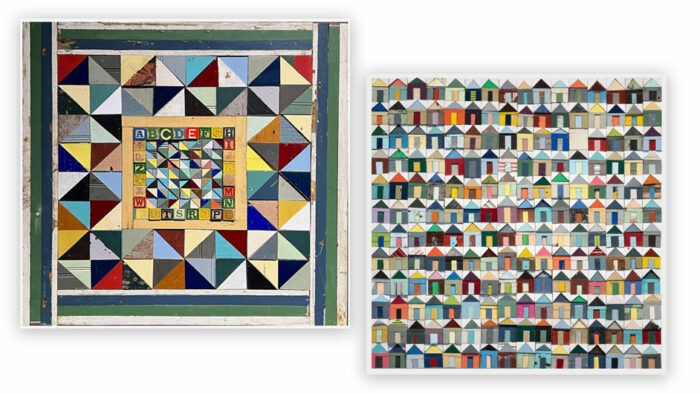
In the previous part of the Wooden Quilt story, I showcased the incredible work of Rose Vickers, highlighting the artistry and intricacies of her creations. This time, we shift our focus to Laura Petrovich-Cheney, an artist whose work and achievements in the niche of quilted wood creations are among the most recognized and celebrated.
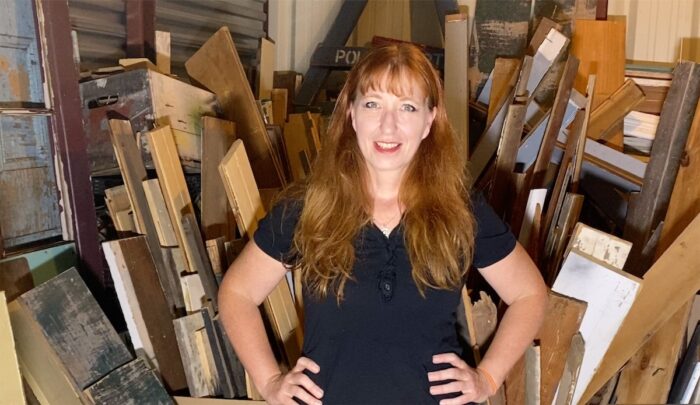

Laura Petrovich-Cheney is an artist known for her meticulously handcrafted wooden quilts, which seamlessly blend aesthetics with environmental consciousness. Her art pieces encapsulate the history of reclaimed wood, including materials salvaged from demolished homes and buildings devastated by natural disasters. Her approach to these intricate wooden quilts is a masterful blend of artistic vision and environmental responsibility.
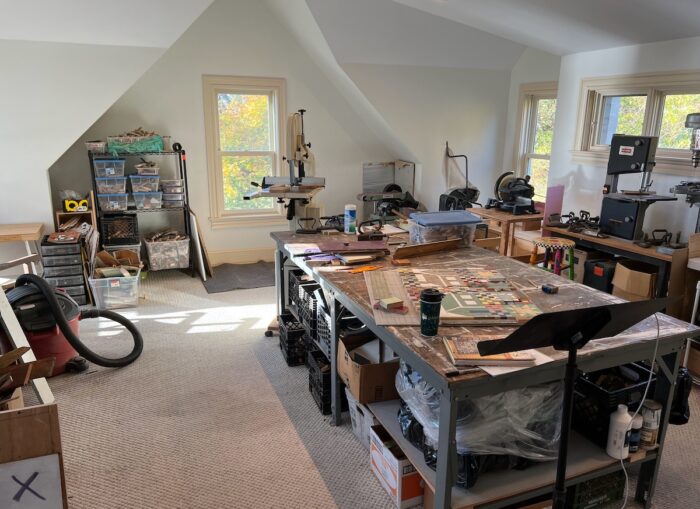
The heart of Laura’s creative process lies in her careful selection of materials. She collects discarded solid-wood boards, windows, and doors from dumpsters and demolition debris piles, and she organizes them in bins according to their predominant color. She explains, “First, my storage unit and garage hold the large pieces, like the kitchen cabinets, large planks of flooring, and dressers. They are piled up against the wall or in barrels and arranged mostly by color, sometimes by size. From there, I will visit the storage unit and bring the pieces home. I cut them into smaller pieces of 12 in. to 36 in. long. These mid-size pieces go into plastic tubs or milk crates. Lastly, all the smallest scraps, anything under 6 in., are put into small plastic bins or milk crates.”

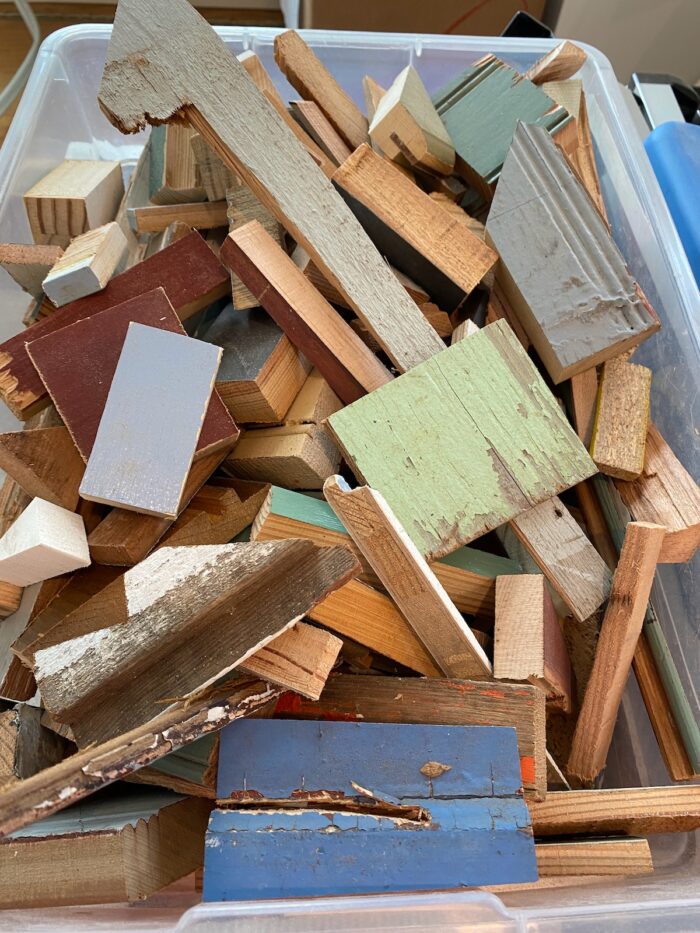
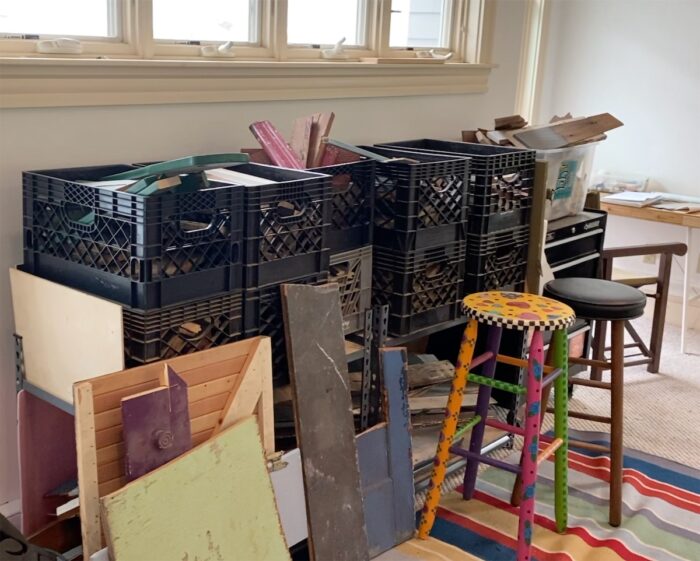
She begins her quilt work with quarter-inch plywood panels obtained from a local lumberyard. These panels are meticulously primed and coated with a flat gray color, not just for visual appeal but also to conceal the imperfections often found in salvaged wood.

Laura’s artistic process mirrors traditional quilting techniques, and she shared, “I begin in the center and work my way outward, just like a quilter topstitching layers together.” She glues the pieces down and uses antique pressing irons, each lined with soft velvet and sourced from flea markets. These irons serve not only as weights until the glue cures but also as a reminiscent touch of nostalgia from her past as a student of design. Laura told me, “When I was studying fashion design at Drexel University, I was unable to afford the new sewing/pattern weights, so I bought these old irons at flea markets and lined them with soft velvet. Then, when I began making wooden quilts, I remembered the irons and began using them to hold things in place and to apply pressure on the pieces to ensure better contact with the glue and surfaces. They embody resourcefulness and a touch of nostalgia from my past.”




The intricate patterns on the plywood are crafted with precision, guided by Laura’s creative vision. “I use a white-colored pencil to mark where the quilt segments will be glued down. The letters denote the different shades of wood,” she explained. In a recent work created for the Boston Children’s Museum, she made use of repurposed letter blocks. “The letter blocks were found in a box of old wood scraps from a yard sale that my husband thought would be a wonderful gift for me. For a number of years, I had them in my studio, wondering when a good time would be to use them. This opportunity at the Boston Children’s Museum was perfect!” She was happy to share. “These letters add depth and character to each piece, making every quilt a unique work of art,” she stated. These letter blocks are ingeniously integrated into her works, infusing each piece with a sense of history and individuality.








Laura confronts the ongoing debate between epoxy and PVA wood glue when selecting adhesives for her projects. “Epoxy offers stability and resistance to moisture, making it my choice for various materials, such as painted MDF or particle board,” she pointed out. “However, when connecting sold wood to solid wood or unpainted plywood, PVA wood glue’s adhesion works beautifully.” Her application of epoxy glue is precise, ensuring a well-organized layout of all the wooden pieces during the drying process.

In Laura’s own words, “My wooden quilts are not just artworks; they are a reflection of my commitment to sustainability, resourcefulness, and the inherent beauty of imperfections. They invite viewers to appreciate the art of repurposing materials to create something new and meaningful.”

Laura Petrovich-Cheney’s wooden quilts are rich in color, texture, and composition and showcase her dedication to sustainability, resourcefulness, and the power of transformation. Her ability to turn reclaimed wood into intricate and meaningful wooden quilts is a testament to her innovative spirit and her deep connection to the environment.

With each meticulously crafted piece, Laura invites us to embrace imperfections, celebrate resourcefulness, and experience the art of repurposing in its most beautiful form. As we conclude our exploration of her work, we find ourselves inspired by her artistic vision and her commitment to creating art that transcends boundaries and captures the essence of life itself.


More from Yoav Liberman
Fine Woodworking Recommended Products

Stanley Powerlock 16-ft. tape measure

Blackwing Pencils

Bahco 6-Inch Card Scraper
























Log in or create an account to post a comment.
Sign up Log in